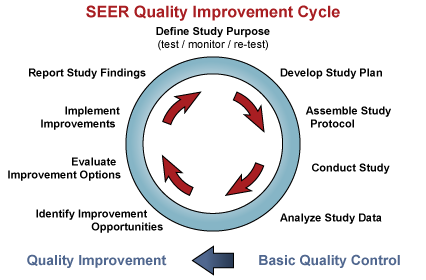Quality Improvement Process
The SEER Quality Improvement (QI) process is decentralized. In addition to the QI staff located in the main office at NCI, the SEER program also utilizes QI staff resident in each of the SEER central registries and outside contractors, all under the direction of the NCI SEER QI Manager.
SEER Decentralized QI Process
- NCI SEER QI staff
- SEER statistician staff
- SEER central registry QI staff
- Contractors
Quality Improvement Cycle
The quality improvement process is cyclical and begins with basic quality control.
- SEER defines the purpose of a study and decides to begin testing.
- A study plan is developed along with a scientific protocol.
- The study is conducted and results are evaluated.
- The cycle continues by identifying opportunities for the improvement.
- Solutions are formulated, evaluated and implemented. Intervention activities follow which include changes to instructional manuals, process modifications, and educational activities with the intent of improving data quality.

Quality Improvement Function
Quality improvement is an ongoing and evolving process. Program activities consist of monitoring and reporting outcomes and results, using the following:
- Instructional coding manuals
- Standard operating procedures
- Data edits
- Data quality and completeness audits
- Special studies
- Education and training activities
SEER QI activities are goal-oriented, protocol-driven, and results-centric. Formal protocols provide a detailed study plan that includes a plan for statistical analysis. Activities include setting standards for data collection by cancer registries, providing technical, instructional coding manuals, as well as scientific resource manuals.
SEER provides training and educational materials that are helpful to cancer registrars seeking credentialing. SEER also leads workshops that provide advanced training in data collection and coding.
Both quantitative and qualitative results from studies are tied directly into the planning and development of targeted education and training materials and programs.
High Quality Data
The SEER Program is viewed as the standard for quality among cancer registries around the world. Each SEER Program registry has a contractual obligation to meet specifically defined data quality goals on an ongoing basis.
The SEER Program has also developed an extensive set of field edits that prevent and correct errors in the data. Electronic edits provide the means to authenticate codes, check for missing data, and check for interrelated data item errors.
Collaborative efforts with national committees and national data standards contribute to high data quality.
